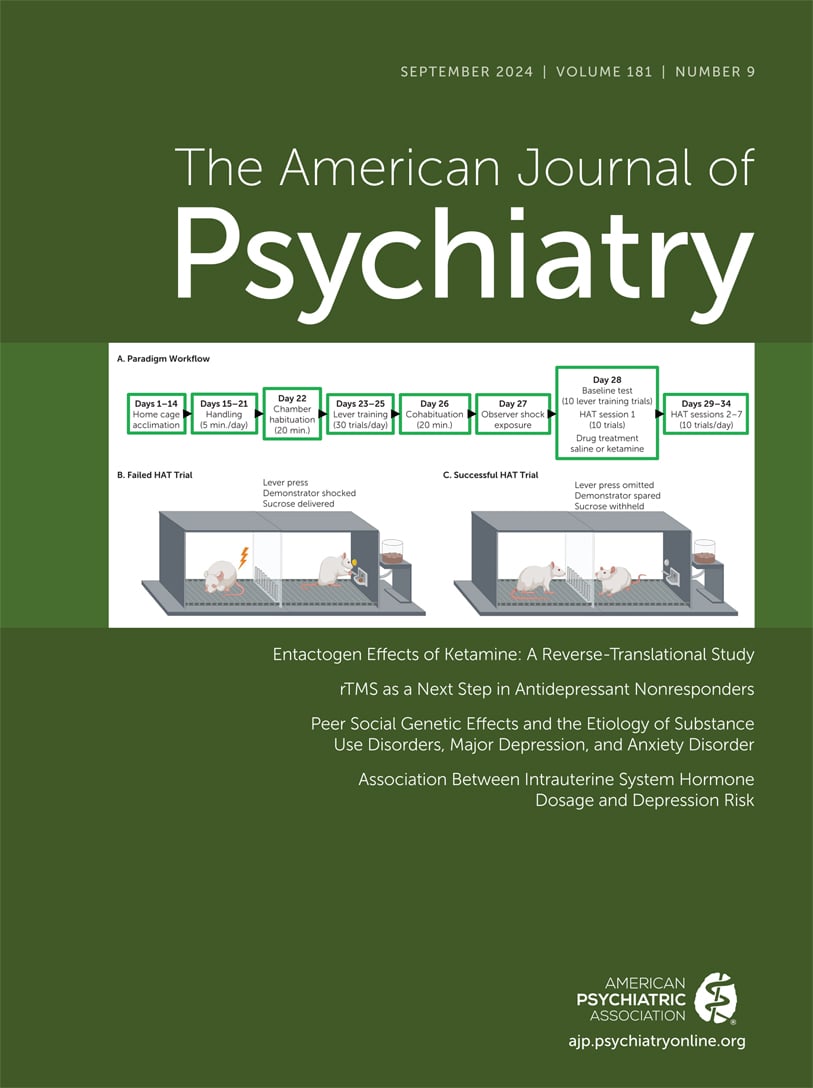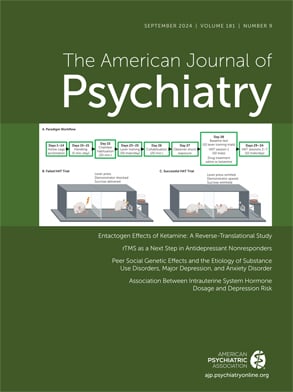Any adult who interacts regularly with adolescents recognizes that adolescents are highly susceptible to the influence of their peers. Peers establish and reinforce norms and behaviors, and adolescents are highly motivated to seek their approval (
1).
The limits of peer influence are less clear, however, and, as Salvatore et al. (
2) propose in this issue of the
Journal, may vary depending on where the boundaries of the peer group are set. Salvatore et al. start from the premise that the peers who influence adolescent behavior are not necessarily people with whom adolescents interact on a regular basis nor with whom they are close. They might simply be other adolescents from their same neighborhoods or schools. Salvatore et al. also ask an intriguing developmental question: assuming these same-age neighbors or schoolmates influence behavior in adolescence (and beyond), are peers from some stages of life more influential than peers from other stages? Finally, and most counterintuitively for some readers, Salvatore et al. propose that peer influences reflect “social genetic” effects, whereby a person’s phenotype (e.g., their behavior or some other characteristic) is influenced by another person’s genotype (
3). Moreover, Salvatore et al. test whether social genetic effects are stronger when a person already has a high genetic propensity for that phenotype.
Salvatore and colleagues use a rigorous design to test these propositions. The sample is large and includes all individuals born in Sweden between 1980 and 1998. These individuals were followed in medical, pharmacy, legal, and national school registries until December 2018, when they ranged in age from 20 to 38 years. These registries allowed the authors to map individuals to the neighborhoods where they lived when they were 15 years old and the schools they attended up to age 19; the authors constructed three neighborhood classifications, reflecting increasingly larger boundaries around a person’s address (from within 1,000 meters up to the municipality level), and three school classifications, identifying the lower secondary schools individuals attended (up to age 16), the upper secondary schools they attended (between the ages of 17 and 19), and the specific tracks in which they were enrolled in their upper secondary schools (vocational vs. college-preparatory tracks). Additionally, the authors used these registries to construct individual-level family genetic risk scores for drug use disorder, alcohol use disorder, major depression, and anxiety disorder, based on diagnostic codes, pharmaceutical prescriptions, and criminal registrations for first- through fifth-degree relatives. Using data from one-half of the sample, the authors generated six peer familial genetic risk scores, aggregated across individuals clustered by birth year and by neighborhoods or schools (three aggregated at the neighborhood level and three aggregated at the school level). These scores were then used in the other half of the sample to predict a proband’s registration for drug use, alcohol use, depressive, and anxiety disorders between the ages of 17 and 30.
The authors found that individuals who lived in neighborhoods or who attended schools where peers had relatively high levels of familial genetic risk also had higher risk of registration for psychiatric disorders in young adulthood than individuals who lived in neighborhoods or attended schools where peers had relatively lower levels of familial genetic risk. Hazard rates were larger for school-based definitions (hazard ratio range, 1.03–1.59) than neighborhood definitions (hazard ratio range, 1.01–1.09) and were larger for substance use outcomes (hazard ratio range, 1.01–1.59) than for major depression and anxiety disorders (hazard ratio range, 1.02–1.19). The largest effect sizes were seen when peers were clustered by the type of program they attended at the upper secondary school level. Here, peer familial genetic risk scores increased the odds of drug use by 1.59 times and alcohol use disorders by 1.56 times. Finally, peer genetic risk effects were stronger for probands who had higher familial genetic risk scores than for probands with lower familial genetic risk scores.
It is uncontroversial that our own risk for psychiatric disorder stems, in part, from our genetic background, but how do we explain peer genetic influences on our substance use or internalizing behaviors? The most obvious explanation is that peer groups with high levels of genetic risk also manifest high levels of psychiatric symptoms that spread via social contagion (
4). For example, another study (
5) found that peers with high genetic risk for smoking were, in fact, frequent smokers, and this largely explained peer genetic effects on their grade-mates’ smoking. Salvatore et al., however, did not find evidence for behavioral mediation of peer genetic effects. Including the aggregate effect of peer registrations for the corresponding disorder in each model barely changed the magnitude of the peer genetic risk effect beyond the reductions associated with controls for individual socioeconomic status and the family genetic risk score for educational attainment.
If peer genetic effects are not mediated by observable symptoms, do we attribute them to “spooky action at a distance,” like Albert Einstein’s disparaging account of quantum mechanics? Maybe, but first we might consider the potential mechanisms by which symptoms spread in a peer group and whether the Swedish registry data were suited to detect those mechanisms at work. One possibility is that exposure to peers’ substance use, depression, or anxiety normalizes and implicitly sanctions the behaviors, emotions, or cognitions that characterize those disorders (
6). For example, exposure to peers who drink or use drugs even occasionally may be sufficient to make adolescents believe that these behaviors are normative and to remove constraints on adolescents’ own substance use. Registrations for psychiatric disorders, however, only reflect symptoms that exceed a certain threshold of severity. By not measuring symptoms that are less severe or frequent, the authors may have been underestimating the behavioral mediation effect. The authors acknowledge this possibility.
Moreover, if exposure to peers’ symptoms is the mechanism through which peer genetic effects influence an individual’s behavior, then logically, the exposure must precede the outcome, with the two occurring in relatively close temporal proximity. In the Swedish sample, however, this temporal ordering is difficult to establish because peer registrations for these disorders were measured up to age 19. This could weaken the aggregate peer behavior effect in two ways. First, the aggregate peer behavior measure could have included registrations that postdated the period when the peer behavior effect was estimated. For example, if the lower secondary school peer genetic effect on risk for registration in young adulthood is mediated by exposure to peers’ substance use or internalizing disorders in lower secondary school, then the aggregate peer behavior effect at the lower secondary school level should only reflect registrations up to age 16. Instead, the aggregate peer behavior effect might have included registrations after age 16 (but by age 19), at a time when the young people who attended lower secondary school together were no longer schoolmates. This would, potentially, dilute the strength of the behavioral mediation effect on the proband’s risk for these psychiatric disorders, because the proband would never have been exposed to those peers’ symptoms. Second, the aggregate peer behavior measure could have included registrations that had long remitted by the time the peer behavior effect was estimated. Again, if exposure is the mechanism of peer genetic effects, then it is unlikely that symptoms from long ago would strongly mediate peer genetic effects on a proband’s risk for a psychiatric disorder in young adulthood.
Finally, to the extent that the exposure mechanism depends on behaviors being observable to others, this may explain why peer familial genetic risk effects for internalizing disorders like depression or anxiety were so much weaker than peer familial genetic risk effects for substance use disorders. Some symptoms of depression or anxiety (e.g., rumination and negative beliefs about the self) may be less easily observable than drug or alcohol use, and highly depressed or anxious individuals may simply withdraw from social interactions, lessening the chances that their symptoms will be observed by anyone but close friends or relatives. Indeed, an interesting hypothesis is that social genetic effects on depression or anxiety are stronger in friendship networks or romantic relationships than among schoolmates or neighborhood peers.
Arguably, the findings reported in Salvatore et al. are impactful, less because they identify peer genetic effects, and more because they demonstrate which peers, at which point in development, most strongly influence risk for psychiatric disorders during the transition to young adulthood. The findings underscore the importance of the school environment in late adolescence, particularly for drug and alcohol use. A future direction for research is to identify which probands are most susceptible to peer effects or to forming misperceptions about how common peers’ substance use behaviors are. Salvatore et al. have taken a step in this direction by demonstrating that probands who are themselves at high genetic risk are particularly vulnerable to peer genetic effects. Interventions that can target the most influential peers and the most susceptible adolescents are likely to be the most effective at reducing rates of psychiatric disorders in the transition to young adulthood (
7).

